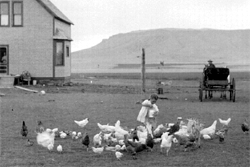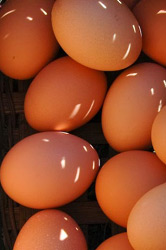Montana's Poultry Industry
Updated: September 14, 2020

Many kinds of poultry are raised in Montana. Poultry is a broad term for chickens, turkeys, ducks, geese, pheasants, pigeons and quail. Montana currently has 410,000 chickens which produce 94,000,000 eggs. Nationwide, that makes Montana 41st in poultry production.
The most common birds raised in Montana are chickens, ducks, turkeys and geese. The larger farms produce most of the poultry in Montana for national and international sale. However, most poultry farmers have less that 5000 birds. They usually do other types of farming also and keep the products for their own use or for local sale.
Nearly all chickens are raised inside. In computerized poultry houses, chickens are fed and watered automatically. The hens live in cages with sloped floors, so when they lay an egg it rolls down to a conveyor belt. All the eggs are then carried to a central collection room. Finally they are washed, graded and packaged in cartons for market.
From the Hen to the Home

- Layer hens live in cages in a temperature and light controlled building. These hens lay approximately 250 eggs per year and will produce eggs for a year and a 1/2.
- Eggs are gathered or carried on a conveyor belt. They are washed and sprayed with a coating oil to replace lost protection by washing.
- A process called "candling" is used by egg examiners to find any imperfections in the shell or inside the egg. This involves holding the egg up to a strong flourescent light and looking inside.
- Eggs are separated by weight and sent to another machine. They are graded into classes called Jumbo, Extra large, Large, Medium, Small and Pee Wee.
- Graded eggs are then placed into cartons.
- The eggs now go to another temperature controlled room to maintain quality and freshness. If an egg is left at room temperature for two or three days it will lose one grade of quality.
- Refrigerated trucks take eggs from the cooler to the supermarket. Most eggs reach the store within 36 hours of when they are laid.
Bigger birds, like geese or turkeys need more room and are kept outside in pens or small fields. The other birds (pheasants, quail, ducks and pigeons) are most often found in the wild. They are usually comparable in size to a chicken, although male pheasants and ducks may get quite a bit larger.

Poultry feed consists of corn, wheat, sorghum or some other type of grain. This grain is mixed with a protein supplement and minerals. To prevent disease and keep flocks clean antibiotics are also added. Birds have a unique feature in their throat called a gizzard. It is where food grinding occurs. In fact, birds sometimes eat tiny rocks which stay in their gizzard to aid in grinding feed.
Poultry provides meat and eggs as well as other by-products. Goose feathers, more often called goose down, provide exceptional warmth. They are used for pillows, blankets, sleeping bags and coats. Materials in eggs enable us to make different vaccines and paint.
Updated: September 14, 2020

